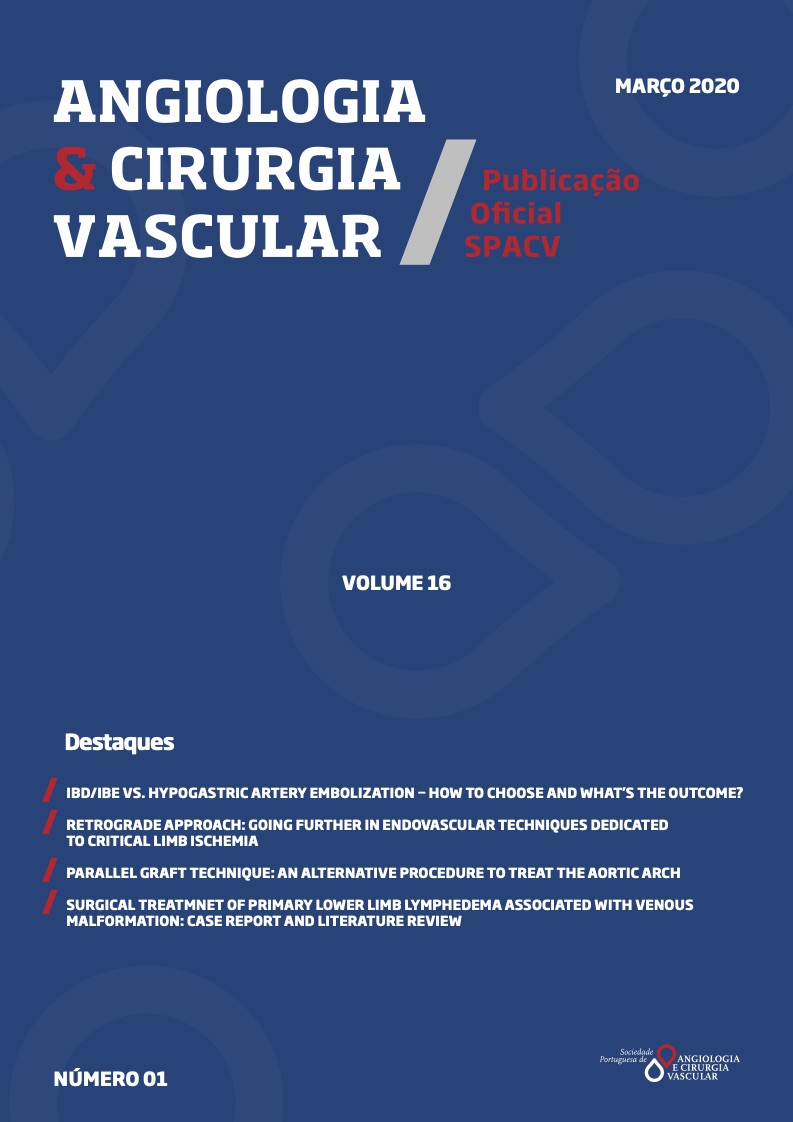IMPORTANCE OF AAA SIZE AS A PREDICTOR OF COMPLICATIONS AFTER EVAR
DOI:
https://doi.org/10.48750/acv.234Keywords:
Endovascular Aneurysm repair, Aneurysm sac, Diameter, OutcomeAbstract
Introduction: EVAR represents the preferred modality for Abdominal Aortic Aneurysms (AAA) repair. However, a comprehension regarding its limits is paramount to avoid future complications. AAA sac diameter has been described as a relevant risk factor for late complications. The purpose of this study is to summarize relevant findings regarding the association between AAA diameter and AAA-related complications.
Methods: MEDLINE databases were searched to identify data addressing specific information on the relation between AAA sac diameter and incidence of AAA-related complications. Only articles in English language between 2003 and 2019 was included. Primary endpoint was freedom from aneurysm-related complications.
Results: Five studies were included in our report, including 8443 patients. In two of the included studies patients with larger AAA sacs were at increased risk for aneurysm-related complications after EVAR (HR 1.02 per mm increase CI95% 1.01–1.04 and HR 1.8 95% CI, 1.20–2.72; P = .005). Two studies reported a higher risk of post implant ruptures (HR: 7.7 CI95% 3.1–18.7;) and late conversions (HR 1.6 CI 95% 1.1–2.3) in patients with AAA diameters over 6 and 6.5 cm, respectively. Finally, one study reported a higher rate of neck-related events in patients with AAA diameter > 65mm [HR: 6.4 (2.3–17.7)].
Conclusion: AAA diameter is a relevant risk factor for late complications. However, research is needed to clarify is these are attributable to the challenging associated anatomy or to the space free of thrombus within the sac. Judicious technique choice along with tailored follow-up strategies are advised in this subgroup of patients.
Downloads
References
2. Patel R, Sweeting MJ, Powell JT, Greenhalgh RM. Endovascular versus open repair of abdominal aortic aneurysm in 15-years' follow-up of the UK endovascular aneurysm repair trial 1 (EVAR trial 1): a randomised controlled trial. Lancet (London, England) 2016;388:2366–74.
3. Nordon IM, Karthikesalingam A, Hinchliffe RJ, Holt PJ, Loftus IM, Thompson MM. Secondary interventions following endovascular
aneurysm repair (EVAR) and the enduring value of graft surveillance. European journal of vascular and endovascular surgery : the official journal of the European Society for Vascular Surgery 2010;39:547–54.
4. Peppelenbosch N, Buth J, Harris PL, van Marrewijk C, Fransen G. Diameter of abdominal aortic aneurysm and outcome of endovascular
aneurysm repair: does size matter? A report from EUROSTAR. J Vasc Surg 2004;39:288–97.
5. Huang Y, Gloviczki P, Duncan AA, et al. Maximal aortic diameter affects outcome after endovascular repair of abdominal aortic aneurysms. J Vasc Surg 2017;65:1313–22.e4.
6. Baderkhan H, Goncalves FM, Oliveira NG, et al. Challenging Anatomy Predicts Mortality and Complications After Endovascular Treatment of
Ruptured Abdominal Aortic Aneurysm. J Endovasc Ther 2016;23:919–27.
7. Bastos Goncalves F, Hoeks SE, Teijink JA, et al. Risk factors for proximal neck complications after endovascular aneurysm repair using the endurant stentgraft. European journal of vascular and endovascular surgery : the official journal of the European Society for Vascular Surgery 2015;49:156–62.
8. Bastos Goncalves F, Baderkhan H, Verhagen HJ, et al. Early sac shrinkage predicts a low risk of late complications after endovascular aortic aneurysm repair. The British journal of surgery 2014;101:802–10.
9. Waasdorp EJ, de Vries JP, Hobo R, Leurs LJ, Buth J, Moll FL. Aneurysm diameter and proximal aortic neck diameter influence clinical
outcome of endovascular abdominal aortic repair: a 4-year EUROSTAR experience. Annals of vascular surgery 2005;19:755–61.
10. Sweet MP, Fillinger MF, Morrison TM, Abel D. The influence of gender and aortic aneurysm size on eligibility for endovascular abdominal
aortic aneurysm repair. J Vasc Surg 2011;54:931–7.
11. Patel N, Bryant A, Duncan K, Kukreja P, Powell MF. Cost comparison of intrathecal morphine to intravenous patient-controlled analgesia
for the first 24 h post cesarean delivery: a retrospective cohort study. J Anesth 2017;31:44–50.









